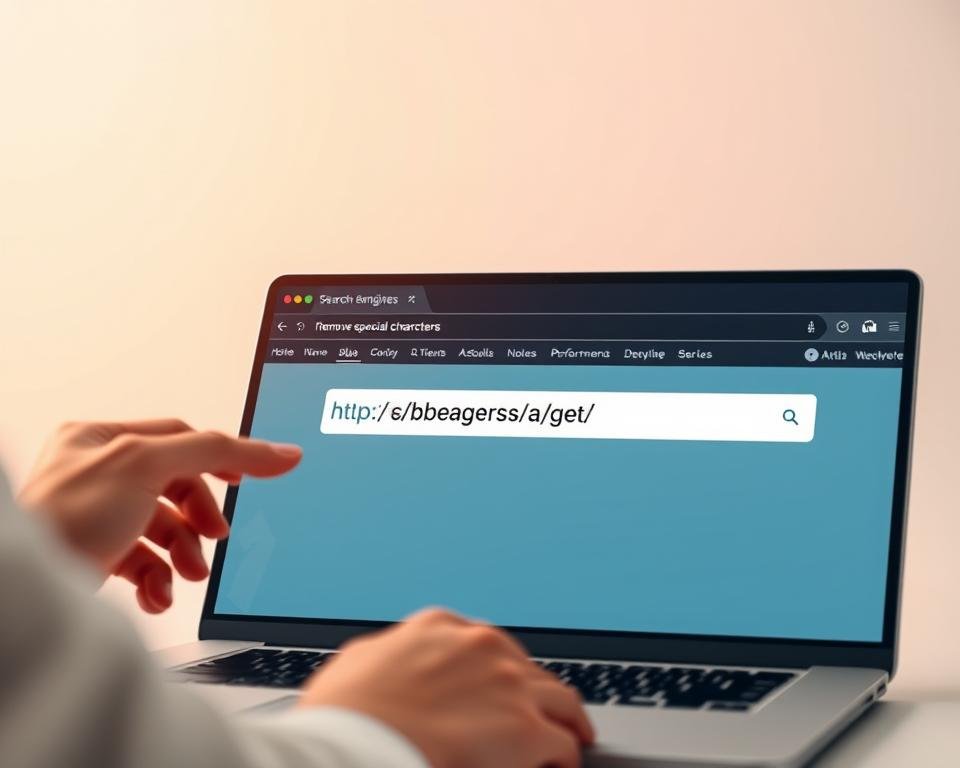Making SEO-friendly URLs is key for a strong online presence. A good URL helps search engines get what your page is about. This brings more visitors to your site.
I’ll show you how to make a URL structure that’s easy for users and search engines. You’ll learn why a clear URL matters. Plus, you’ll get tips to make your site more visible online.
Key Takeaways
- Understand the importance of SEO-friendly URLs for your website.
- Learn best practices for crafting a clear and concise URL structure.
- Discover how a well-structured URL can enhance your website’s visibility.
- Implement a URL structure that is both user-friendly and optimized for search engines.
- Improve your website’s search engine ranking with a well-crafted URL.
Why URL Structure Matters for SEO
A good URL structure is key for better search rankings and user experience. It helps search engines understand your website’s content and layout.
URLs are more than just web page addresses. They give search engines important info about your site’s content and structure. A well-organized URL can boost your site’s search rankings and keep users engaged.
The Role of URLs in Search Rankings
URLs are a big deal for search rankings. They help search engines see how relevant and contextual a webpage is. This makes it easier for them to index and rank your page. Including target keywords in your URL can make your page more visible in search results.
Key benefits of optimized URLs for search rankings include:
- Increased relevance for search queries
- Improved crawlability by search engines
- Better indexing of web pages
User Experience and Click-Through Rates
A well-structured URL can also improve user experience and click-through rates. Clear and descriptive URLs help users know what to expect from a webpage. This makes them more likely to click on it.
| URL Characteristic | Impact on User Experience | Impact on Click-Through Rates |
|---|---|---|
| Descriptive and clear | Increases trust and understanding | Higher click-through rates |
| Short and concise | Improves readability and memorability | More likely to be shared |
| Keyword-rich | Enhances relevance for users | Better visibility in search results |
By optimizing your URLs and following SEO tips, you can make your site more user-friendly and search engine-friendly.
Best Practices for URL Length
Knowing the best practices for URL length is key for search engine optimization. The length of a URL affects its performance in search results. It’s important to find the right balance.
A URL that’s too long can be hard to handle. It might get cut off in search results. On the other hand, a URL that’s too short might not tell you enough about the page.
Finding the ideal URL length is key to creating a URL structure that is both user-friendly and SEO-optimized.
Ideal URL Length for SEO
SEO experts often debate the ideal URL length. There’s no single answer, but a good rule is to keep URLs short and clear. Studies show that URLs with fewer than 5 words are best. They’re easier for users to read and remember.
Effects of Short vs. Long URLs
The length of a URL affects both user experience and search rankings. Short URLs are easier to use and share. But long URLs can give more details and context.
Short URLs: Easier to read and remember, more user-friendly.
Long URLs: More descriptive, provide more context, but can be cumbersome.
To create effective URLs, find a balance between being short and descriptive. By following the best practices for URL length, you can make URLs that are good for both users and search engines.
Using Keywords in Your URL
Keywords are key to making your URLs SEO-friendly. Adding the right keywords to your URL can make your page more visible on search engines.

Importance of Keyword Placement
It’s not just about adding keywords to your URL. It’s about doing it in a way that’s good for both users and search engines. A good URL is easy to read and understand.
Put the most important keywords at the start of your URL. This helps search engines know what your page is about. It also makes your URL show up better in search results.
Tools for Keyword Research
To use keywords well in your URLs, you need to find the right ones. Keyword research tools are very helpful here. Tools like Google Keyword Planner, Ahrefs, and SEMrush help you find keywords people are searching for.
- Google Keyword Planner: Useful for finding keywords and getting an idea of their search volume.
- Ahrefs: Provides detailed insights into keyword rankings and suggests related keywords.
- SEMrush: Offers a full view of keyword analysis and competitor research.
Using these tools, you can make a list of keywords to use in your URLs. This boosts your webpage’s SEO.
Implementing a Logical Hierarchy
To make your site better for users and search engines, a logical hierarchy is key. A good URL structure helps search engines understand your site. It also makes your site easier for users to navigate.

Creating a Clear Site Structure
Organizing your content in a clear way is important. It should be easy for users and search engines to follow. Use main categories and subcategories for your content.
For example, an electronics website might have “Laptops” as a main category. It could have subcategories for different brands or specs. Your URLs should show this structure, helping everyone find their way.
A well-organized site is also easier to update. You’ll know exactly where everything is and how it connects.
Benefits of a Well-Organized URL
A well-organized URL structure brings many benefits. It boosts SEO performance, makes your site easier to use, and helps search engines find your content. This can lead to better rankings.
- Improved SEO performance due to clear content organization.
- Enhanced user experience through intuitive navigation.
- Better crawlability, ensuring all content is indexed by search engines.
By using a logical hierarchy in your URLs, you can make your site more visible and user-friendly. This helps with your URL structure SEO techniques and improving website URLs.
Choosing the Right URL Format
Creating an SEO-friendly URL structure is key. The format of your URL matters a lot.
I will look at dynamic and static URLs. I’ll give examples to help you pick the best URL for your site.
Dynamic vs. Static URLs
URLs can be either dynamic or static. Dynamic URLs change and have query strings. Static URLs stay the same and don’t change.
- Dynamic URLs:
example.com/products?id=123 - Static URLs:
example.com/products/123
Static URLs are better for SEO. They are easier to read and understand.
Examples of Effective URL Formats
Good URL formats help your site get seen more. Here are some examples:
example.com/category/subcategory/productexample.com/blog/post-titleexample.com/about/team
These URLs are clear, easy to read, and have the right keywords.

The Importance of Hyphens and Underscores
Knowing how to use hyphens or underscores in URLs is key for SEO success. The choice between them can change how search engines see and rank your page.

Best Practices for Word Separation
Hyphens are the best choice for separating words in URLs. Google sees hyphens as word separators. This makes URLs like “example.com/seo-friendly-url” better for SEO than “example.com/seo_friendly_url”.
But, Google doesn’t see underscores as word separators. This makes hyphens the top pick for URLs. Yet, keeping your URL structure the same is also important to avoid confusion.
How Google Interprets Characters
Google sees hyphens as spaces between words. This helps it understand your URL’s context and relevance. This can make your page more visible in search results.
But, Google sees underscores as just connectors. This might make your URL look like one long word.
To get the most SEO benefits, use hyphens for word separation. This follows Google’s rules and makes your URLs easier to read.
Avoiding Special Characters in URLs
Special characters in URLs can cause big problems. They make it hard for search engines to read and crawl your site. This can lead to indexing issues and crawl errors.
Special characters can also make your URLs look spammy. This might lower the number of clicks you get.
Common Mistakes to Avoid
One big mistake is using special characters like %, &, $, or ?. These characters have special meanings in URLs. Using them when you don’t need to can cause confusion.
- Using % or other encoded characters unnecessarily
- Including & or ? in URL paths
- Using $ or other special characters that have specific meanings in URLs
Alternative Solutions for Special Characters
Instead of special characters, use hyphens (-) or underscores (_) to separate words. Hyphens are better for readability and SEO.
For example, example.com/best-seo-practices is better than example.com/best_SEO_practices or example.com/best%20seo%20practices.

| Character | Recommended Alternative | Reason |
|---|---|---|
| % | – (Hyphen) | Avoids encoding issues |
| & | / (Forward Slash) | Separates URL paths clearly |
| $ | – (Hyphen) | Enhances readability |
By avoiding special characters and using better alternatives, you can make your site easier to use and better for SEO.
Understanding URL Redirects
Managing URL redirects is key for a smooth website update or migration. They help keep SEO equity and ensure users and search engines find your content’s new spot.
When I update or move a website, knowing about different redirects is vital. This knowledge helps me use redirects wisely, avoiding harm to my site’s search ranking.
Types of Redirects and Their Impact
There are many types of URL redirects, each with its own role. The most common are 301, 302, and meta refresh redirects.
- 301 Redirects: These are permanent redirects that show a URL has moved for good. They’re the best for SEO.
- 302 Redirects: These are for temporary moves. They’re good for quick fixes but can hurt SEO if misused.
- Meta Refresh Redirects: These are set at the page level. They’re useful for delayed redirects but are less SEO-friendly.
Knowing how these redirects affect SEO is key. For example, 301 redirects keep link equity and are the top choice for permanent URL changes.

How to Implement Redirects Safely
To safely use redirects, I follow best practices to avoid SEO harm.
- Use 301 Redirects for Permanent Changes: For permanent URL changes, 301 redirects tell search engines to update their indexes.
- Avoid Redirect Chains: Redirect chains, where a URL redirects to another, then another, can weaken link equity and slow sites.
- Monitor Redirects: Keeping an eye on redirects helps spot and fix problems fast. Google Search Console is great for tracking redirect performance.
By correctly using URL redirects, I can smoothly update or migrate my website. This keeps my SEO equity and user experience intact.
The Role of HTTPS in URL Structure
HTTPS is key in making URLs safe and better for search engines. It’s not just about security. It also helps with SEO.
HTTPS, or HyperText Transfer Protocol Secure, makes sure your website is safe. It keeps your data safe by encrypting it. This stops others from seeing your info.
Security and SEO Benefits
HTTPS brings many benefits. It makes your site safer and can help it rank better in search engines. This is because HTTPS shows your site cares about security.
Key benefits of HTTPS include:
- Enhanced security through data encryption
- Protection of user data and privacy
- Improved trust and credibility among users
- A possible ranking boost in search engines
Steps to Migrate to HTTPS
Switching to HTTPS needs careful steps. This avoids hurting your site’s SEO and user experience.
- Get an SSL/TLS certificate from a trusted source.
- Put the SSL/TLS certificate on your web server.
- Change your site’s links to HTTPS.
- Set up 301 redirects to HTTPS to keep users and search engines on the secure site.
- Update your sitemap and tell search engines about your HTTPS site.
Here’s a quick guide to switching to HTTPS:
| Step | Description | Considerations |
|---|---|---|
| 1. Obtain SSL/TLS Certificate | Get a certificate from a trusted CA | Choose the right type of certificate (DV, OV, EV) |
| 2. Install SSL/TLS Certificate | Install the certificate on your server | Follow the server software’s installation instructions |
| 3. Update Internal Linking | Change HTTP URLs to HTTPS | Ensure all internal links are updated |
| 4. Implement 301 Redirects | Redirect HTTP traffic to HTTPS | Use server-side redirects for efficiency |

Knowing HTTPS’s importance and following these steps can make your site safer. It can also help your site rank better. This makes your URLs better for SEO.
Monitoring and Analyzing URL Performance
Checking how well your URLs work is key to bettering your SEO. By watching your URL performance, you learn how people use your site. This helps you make smart choices to boost your SEO.
Tools for Tracking URL Effectiveness
Many tools can track your URLs. Google Analytics shows how users move through your site. It tracks things like page views, bounce rates, and how long people stay.
Ahrefs and SEMrush do deep SEO checks, including URL analysis. They spot problems like broken links and find ways to improve.
| Tool | Key Features | Benefits |
|---|---|---|
| Google Analytics | Page views, bounce rates, session duration | Understand user behavior |
| Ahrefs | SEO audits, backlink analysis | Identify optimization opportunities |
| SEMrush | Technical SEO audits, competitor analysis | Enhance SEO strategy with competitor insights |
How to Adjust Based on Analytics
After looking at your URL data, you can tweak your SEO plan. If some URLs get a lot of bounces, you might need to make the content better or the site easier to use.
By checking your analytics often, you can make your SEO better. This ensures your URLs work well for both search engines and visitors.
Future-Proofing Your URL Structure
Search engine algorithms keep changing. Having a good URL structure is key for lasting success. It’s important to keep up with SEO trends to stay ahead online.
Staying Ahead of the Curve
To keep your URL structure strong, know the latest best practices. Keep an eye on search engine updates and adjust your URLs. This way, your site stays visible and competitive.
Best Practices for Long-Term Success
It’s important to check and improve your URL structure often. Stay current with SEO trends and algorithm changes. This helps your URL structure stay effective and avoids problems.
Focus on an SEO-friendly URL structure and be flexible. This will help you succeed online for a long time.
